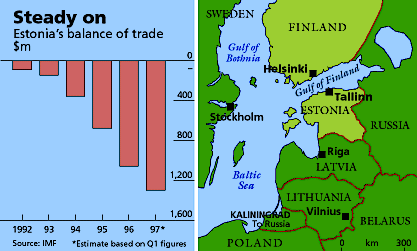EUROPE
Out and not so sure
T A L L I N N
Finland in and happy
Not everyone in Estonia’s capital, Tallinn, is quite so eager. Estonia has a remarkably liberal, open and fast-growing economy. The private sector accounts for three-quarters of GDP, more than in most EU countries. Corporate and income taxes are levied at a flat rate of 26%. Unemployment is around 4%. Most tariffs and subsidies have been scrapped. And Estonia’s currency board, which pegs its exchange rate at eight-for-one to the D-mark, has cut inflation nearly to single figures.
In these circumstances, joining the EU, with all its rules and costly farm subsidies, could be a step backwards. When they cross the Gulf of Finland, some Estonians say it’s “back to socialism”. A top man in the Bank of Estonia hopes EU membership will not come too soon, because Estonia is too poor to afford Europe’s misguided economics. It would have been better, he jokes, to join the North American Free-Trade Agreement.
